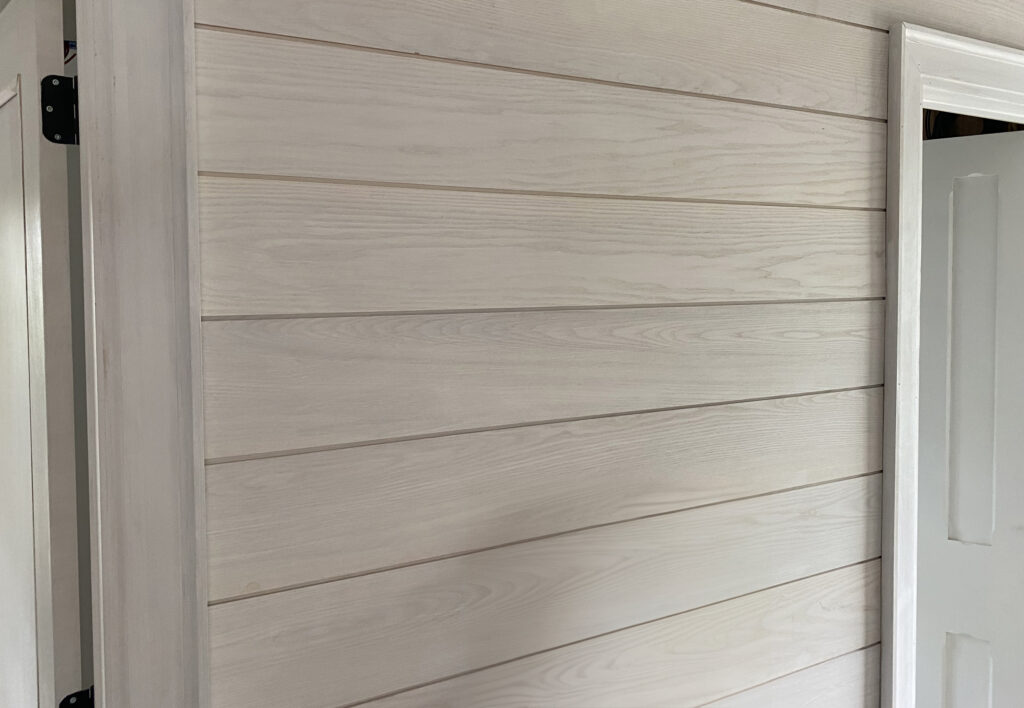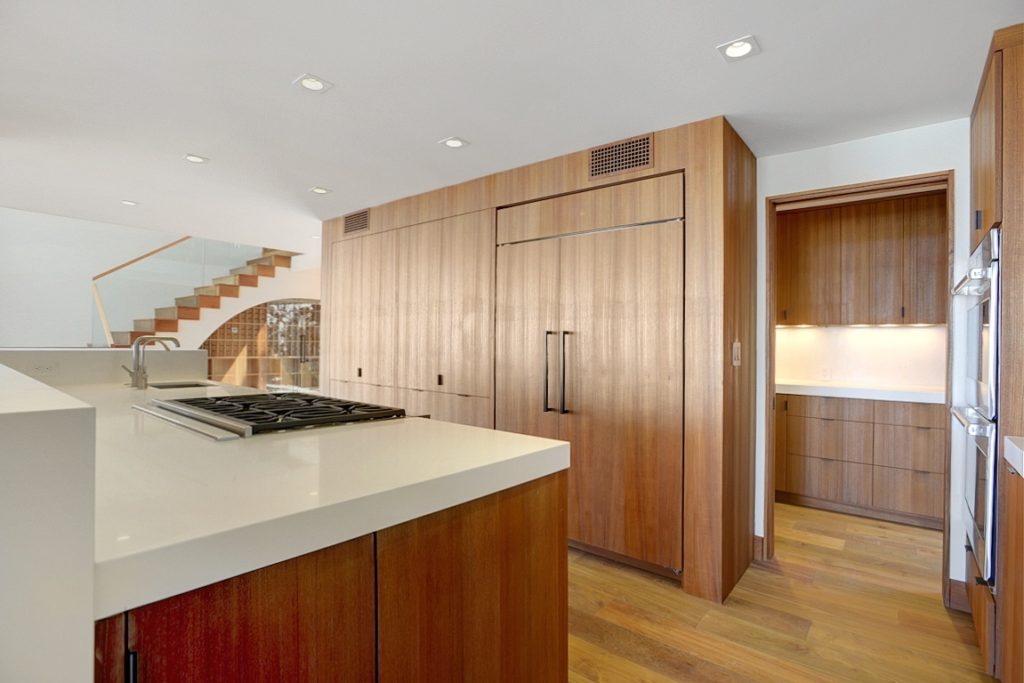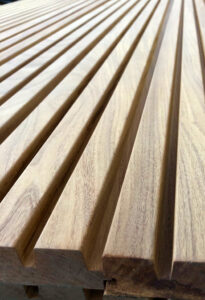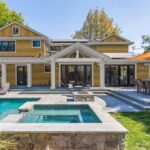Organic Modern style is all about clean lines and natural tones. But warmth is necessary. So is light. Actually the interplay of light on warm surfaces might be the better way to define Organic Modern design. Without these you get sterile, museum like spaces with white walls and white floors and surly looking docents making sure you don’t touch anything. Wood is the key element, the critical differentiator, that makes the Organic Modern style what it is. For that matter, wood is what makes Organic Modern so popular among architects and designers.
Wood provides nearly infinite options to make the design your own. Other natural materials come close, but they don’t provide the interesting light reflective values, the depth and luster of wood under varying light conditions, or the organic texture and grain patterns that keep your eye guessing. Stone and plants and natural fibers get close, but they don’t have the same variability in appearance yet ironically, the consistency. Wood can be wire brushed or scraped to create a physical texture that light bounces off unpredictably. Or it can be planed smooth for a consistent sheen allowing the light to absorb and pull out the warm tones while the grain tells the story. As a flexible design medium, wood is nearly perfect.
Wood design is Organic Modern design

What is the Organic Modern style?
Clean lines and the integration of natural materials is at the heart of Organic Modern Design. It is the intersection of clean, consistent modernism and natural variability. This style is not only on trend but exemplifies the union between sleek modern design and the warmth that organic materials like wood can bring. It’s the perfect choice for those who like the look of modern architecture but not necessarily the somewhat cold and sterile atmosphere it can create. Modern style is characterized by clean lines and minimal color. You see a lot of white, grey, glass, and concrete in modern architecture and minimalist style interior design. By adding in the organic wild card wood, we get more neutral and earth tone colors. We get a warmer, perhaps more comfortable, take on modern design.
As stated before, there is a great deal of emphasis put on natural light in this style as well. One could say light adds the action to the scene in how it bounces and sinks into the surfaces. So it is common to see large windows and very open layouts. Organic Modern Design is malleable and can be adjusted to fit within the geography of the structure. For instance, this style would look very different for a coastal home compared to one in a forest or mountains. The natural elements inside blend with the natural elements outside. Not only is the natural element a great way to blend indoor and outdoor spaces, but Organic Modern is a perfect way to add more color to a home without sacrificing modern architecture.
Is is still Organic Modern without regional consistency? Can you use beach themed natural materials in a home in the Olympic region temperate rainforest? Is this Fusion Organic Modern?…or just confusing?
Organic Modern For exterior design?

Utilizing Organic Modern Design on the exterior of a home is best shown through cladding. Simple profiles such as rainscreen will create those clean lines that are integral to the style. More intricate profiles such as board & batten or bevel edged would take away from the sleek modern feel. As shown in the photo below, this Ipe rainscreen allows for the floor-to-ceiling windows to be the focal point and provides a great backdrop to the landscaping. The deep red-brown color is a warm contrast to the greenery and even the bright blue sky above.
The Cedar employed on the soffits contrasts with the Ipe yet the two play off one another as the Cedar pulls the red warm tones even up into the heavily shadowed regions of the structure. Certainly stone is a natural material and is often used on the exterior of a home to capture the natural element. But with stone you lose some of the variety of color while introducing more texture which could sabotage the clean, modern feel. Wood is the perfect material to hit all the design elements.

Organic Modern Style (Wood design) for interior design?
Here is a California home that showcases the Organic Modern style for interior design. The kitchen space features Teak cabinetry with concealed hinges and flush fit doors that complements the smooth white texture of the countertops. Yet note the stark contrast with the white with honey brown warmth and visual interest provided by the wood grain. The modern design of this cabinetry is simple and sleek allowing the beauty of the natural wood to be the focal point rather than raised panels, hardware and moulded details.

The bathroom shown below also utilizes Teak to contrast the white walls, countertop, and stand-alone bathtub. Floor to ceiling windows and an open floor plan again provide the action with ample light to bounce and jump around the space. It is the warmth which the Teak wood brings that prevents this room from looking sterile. A skylight that can be seen through the mirror provides even more natural light, lessening the need for harsh lighting during the day and even more interest as the day wears into twilight. Smooth, straight lines dominate, but it is the movement of the light and how that interacts differently with the natural surfaces that makes this Organic Modern.

While neither of these rooms are shown in their fully furnished forms, it’s clear that they both embody what Organic Modern Design is and can only be played upon more with décor. Organic Modern Design inside the home typically features earth tones – taupe, terra cotta, and earthy greens – in the form of furniture, textiles, or live plants. Very rarely do we see these colors implemented through painting the walls, as Organic Modern Style is characterized by simple white walls that can allow the wood to be the narrator of the story which the designer wants to tell.
Which woods for Organic Modern design?
Any species of wood can be implemented within an Organic Modern Design framework. It comes down only to color palette, personal style, and of course interior or exterior application which relates to the particular species’ durability in harsh weather conditions. Lighter colors are seen more often but rather than bright whites like Maple, species with more beige and earth tones like Beech or White Oak show up more often. But darker colored woods can make a huge statement too. Ipe and Cumaru have both been shown in this article to be effective. Walnut is another deep brown wood species that when used sparingly can provide contrast and warmth. Exotic and rich, dark colored woods are kind of a secret Organic Modern weapon as they provide more bang for the buck. A tiny bit of Garapa on the ceiling goes a long way allowing the rest of the room to play up the clean lines and inorganic materials.

Additionally, species with a more pronounced grain like White Oak or, as we have seen above, Teak can be another design tool. The additional grain interest allows for a unique look that can pass as texture despite the smooth planed surface. As shown in the prior pictures, wood can be implemented in a variety of ways both inside and out. Exterior cladding or decking is a large scale way to add organic materials to a modern design. Inside, when modern design would suggest smooth white finishes throughout the space, adding the natural wood tones in the form of cabinetry, beams, or feature walls really brings the Organic Modern concept to life.
Here is a wall panel profile recently run for a customer at our mill. It’s one of the many options we have that could be utilized in an Organic Modern design. The clean lines that could be displayed vertically or horizontally add a great deal of dimension to a ceiling or feature wall and would add contrast and warmth to a modern space. Notice the slight variation in look from board to board. Now imagine the interplay of light from various angles across the panel. Picture this running up the wall and across the ceiling of a bathroom and starkly contrasting with polished white and nickel fixtures. We love how this profile would be uniform from project to project, but there are unique elements in the wood itself that truly make the finished product one of a kind.


Organic products such as wood can be difficult to sort through. The color of wood alone can be confusing as it will vary so much from board to board. Having access to so many species brings forth the questions of color, durability, and overall longevity. Wood can look so different from species to species and even from board to board. If you truly want to embrace organic modern, then find a firm with the expertise to help you choose the best type of wood for your project in order to achieve a modern and sleek look with these timeless organic elements.
How Do You Do Organic Modern?
Below you’ll find more examples of Organic Modern Style. Which organic element is your eye naturally drawn to? Feature walls, furniture, flooring? Since there are so many ways to implement such elements, let’s hear your thoughts on Organic Modern and how you would go about creating your vision – either interior or exterior. In this style, do you prefer to highlight the natural variation of wood or would you rather see something more consistent? How about color? Are you drawn to lighter or darker wood tones when creating an Organic Modern design? Let us know in the comment section below; we’d love to hear from you!















Leave a Reply